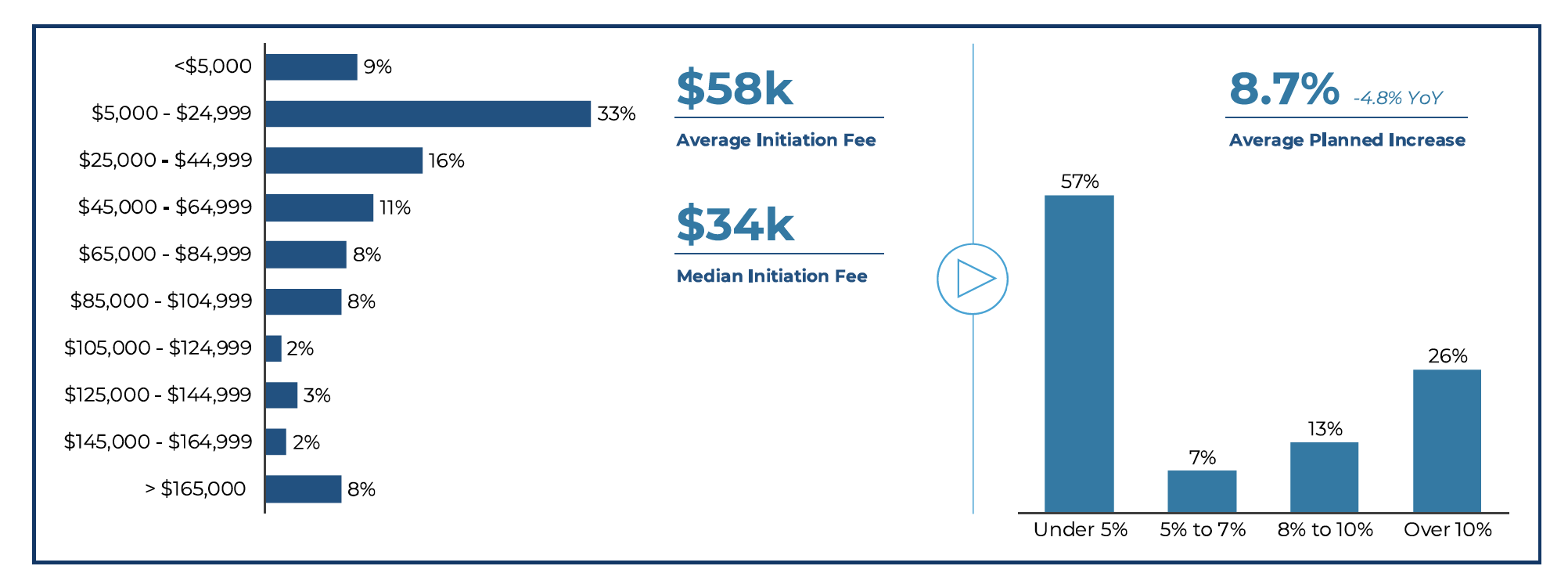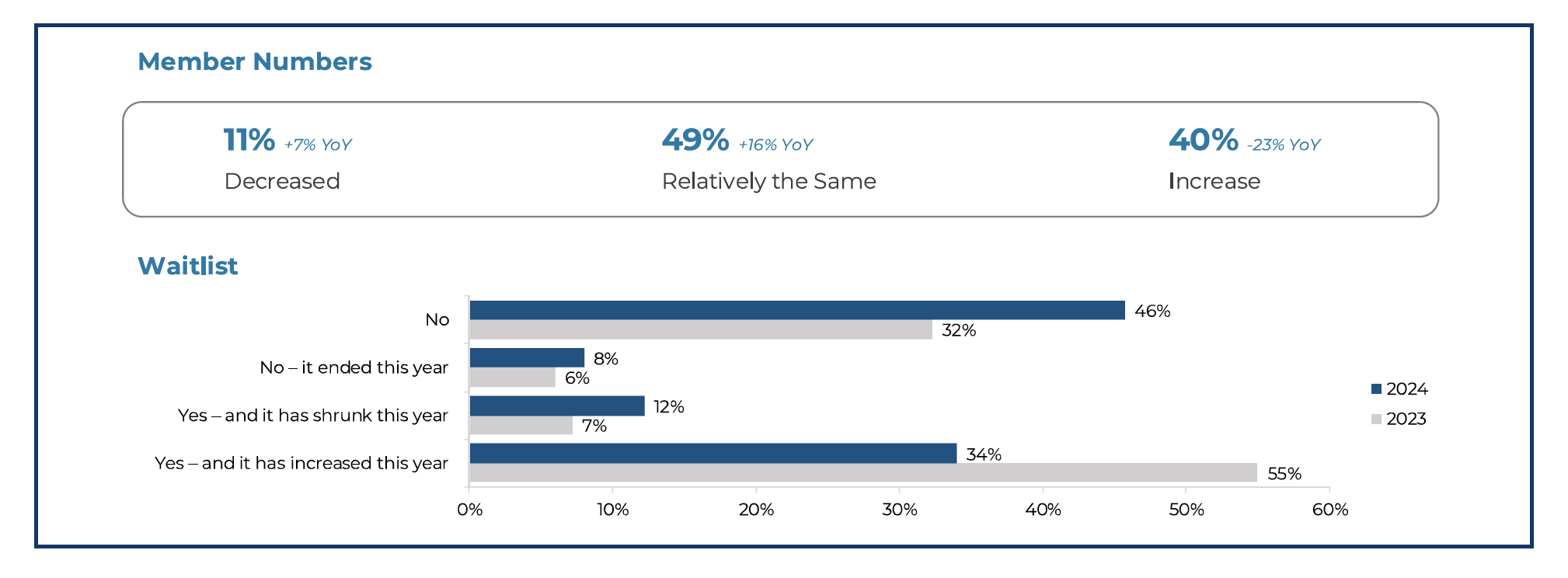Board Brief
April 2025
Designed for Club Board of Directors

Inside this Issue:
-
What’s Hot: The Golden Period: Mastering Governance in Booming Private Clubs
Clear governance is crucial in maintaining a harmonious and well-structured environment within private clubs. There are four pivotal strategies for establishing clear roles and expectations, ensuring all stakeholders work cohesively for the betterment of the club. -
By the Numbers: Strategic Membership Implications in Clubs
The Club Leaders’ Perspective Report captures the pressing needs of club management professionals and examines the emerging trends and challenges these individuals face. In this edition, we’ll take a look at data regarding members, waitlists, and initiation fees. -
Insights: Common Shortcomings of Club Bylaws
The practice of sound governance is the most important factor contributing to the success of a club, and the club’s bylaws are the foundation of its governance. -
PAR Act to Modernize Tax Code for Golf and Country Clubs Reintroduced.
-
CMAA News & Announcements: What are the Business Management Institutes (BMI)?
CMAA offers a full complement of BMI offerings throughout the year. -
CMAA News & Announcements: Upcoming Governance & Leadership Symposium on April 16
Do you want to be better prepared for your role as a club leader?

What’s Hot
The Golden Period: Mastering Governance in Booming Private Clubs
We’re seeing tremendous organizational growth and development in private clubs, many are thriving with robust finances and expanded membership lists. However, this golden period can inadvertently lead to a sense of overconfidence among stakeholders such as board members, committees, and management, potentially leading them to overstep their roles.
The Importance of Clear Governance
Clear governance is crucial in maintaining a harmonious and well-structured environment within private clubs. It ensures that board members, committees, and management work cohesively toward the club’s betterment. Consider these four pivotal strategies for establishing clear roles and expectations, ensuring all stakeholders work cohesively for the betterment of the club.
Strategy 1: Develop a Comprehensive Governance Packet
Develop a comprehensive governance packet for board members, detailing their roles, commitments, responsibilities, conflict of interest policies, confidentiality agreements, and more. Mandate an annual review of these documents as part of the board orientation process.
Strategy 2: Define Committee Charters
Ensure committees operate under a well-defined charter that outlines their goals and objectives, aligning seamlessly with the club’s strategic vision.
Strategy 3: Utilize a Role Matrix
Utilize a role matrix as a visual guide to clarify the distinct responsibilities of the board, each committee, and the management team. There are a variety of these types of tools that can be effective depending on your governance structure.
Strategy 4: Implement Transparent Selection Processes
Implement a transparent and objective process for nominating and selecting new stakeholders. Define specific qualifications and expectations for all open positions to align new members with the club’s ethos from the onset.
In a period of growth and success, effective governance is the cornerstone of sustained prosperity in private clubs. By adopting these strategies, clubs can ensure a well-organized, transparent, and efficient governance structure that supports their vision and goals.
If uniting your leadership team or establishing a governance framework seems daunting, consider reaching out for a complimentary consultation. Engaging with an impartial third-party facilitator can streamline the process, ensuring unbiased participation and a level playing field.
Insights by Ryan Doerr, President & CEO of Strategic Club Solutions. Ready to enhance your club’s governance? Contact SCS today for a complimentary consultation and start your journey toward effective leadership and management.

By the Numbers
Strategic Membership Implications in Clubs
The Club Leaders’ Perspective Report captures the pressing needs of club management professionals and examines the emerging trends and challenges these individuals face. In this edition, we’ll take a look at data regarding strategy, but you can find more data in the full report.
Membership Remains Strong
Membership remains strong across the industry, but with some minor signs of softening demand that will create strategic implications. This year, respondents indicated a decrease of 23 percent in clubs experiencing an increase in members and a decrease of 21 percent in clubs increasing their waitlist.
Even with shifting demand, clubs continue to increase initiation fees (up 8.7 percent), operating dues (up 6.2 percent), and capital dues (up 12.5 percent) to cover rising costs. Clubs have an opportunity to expand capital dues funding, and this is important considering the lack of member attrition this past year and clubs’ continued aggressive capital investment appetite.
Almost 70 percent of leaders anticipate an improvement in their club’s financial position, a significant 12 percent increase over the previous year. This optimistic outlook reflects respondents’ preparedness for the ongoing risks to clubs, primarily involving employees, rising labor costs, and the shifting economic climate.
To meet the ever-shifting member demands, capital projects continue to focus on dining and golf, along with expanding access to address the popularity of pickleball. These plans resulted in success as respondents indicated that members are showing continued or increasing satisfaction levels.
Membership and Waitlist Growth Changes
Membership demand continues to remain strong throughout the industry, with most clubs either showing continued levels or remaining relatively the same compared to last year.
The explosive growth that clubs experienced post-COVID has slowed compared to last year, even as more than one-third of respondents indicated that their wait lists increased compared to last year. Regarding attractiveness, clubs with less than $5 million in revenues show softer demand in membership and waitlist growth, while larger clubs between $10 and $25 million were more likely to maintain strong demand.
Initiation Fees
Initiation fees continued to grow with an average increase of 8.7 percent, while most clubs are planning an increase of less than 5 percent.
There is still strong growth in initiation fees, but there is a deceleration in increases as this year’s expected increase is almost 5 percent lower than last year’s reported increase.
CMAA members may access their complimentary copy of the full report through CMAA Connect in the Best Practices Exchange Community Library in the CMAA Annual Reports folder.

Insights
Common Shortcomings of Club Bylaws
The practice of sound governance is the most important factor contributing to the success of a club, and the club’s bylaws are the foundation of its governance. They are the members’ instructions establishing boundaries for the board. They must balance the protection of the club, its assets, and stakeholders with the flexibility the board needs to make decisions in an ever-changing landscape. Having read hundreds of bylaws in the more than 25 years I have spent helping clubs with their governance, I have found that some bylaws do this well and some don’t.
Club bylaws vary greatly, from fewer than 2,000 words to more than 9,000. They might describe a nineteenth-century nascent governance system highly dependent upon member volunteers for operational functions or a contemporary system mostly consistent with leading practices. Despite the differences, some shortcomings are common in bylaws that have not undergone rigorous evaluation and update.
Club bylaws are often difficult to read. They can be overly complex, full of legal jargon, too wordy, poorly organized, and challenging to navigate. They are an essential tool and must be written in a style and using language readily recognizable and understood by the typical member.
They often contain contradictions within themselves or might contradict the articles of incorporation, current laws, or the club’s current culture and values. Most commonly, they contradict the club’s actual practices.
Bylaws often establish policies that should be the Board's purview. The bylaws should delegate authority to the Board within limitations and enable the board to delegate as it sees fit to the GM/COO, officers, and committees. The Board can establish and record these policies in the Board policy manual, allowing it to alter them as needed.
It is also common for the bylaws to be silent or too limiting regarding the members’ authority. Members are the owners and should have the right to vote electronically (to simplify and broaden participation) and submit petitions to call a special meeting, propose alternative candidates, add items to a scheduled membership meeting agenda, propose bylaws amendments, and remove one or more directors. The petition process should be rigorous enough that the noisy minority can’t hijack the club’s decision-making, but easy enough for the membership to impact decisions the majority feels are not in the club’s best interest.
These shortcomings often cause club boards to feel the bylaws are an irritant to be worked around or ignored. However, they are legally enforceable, and boards that don’t comply may find themselves in court, defending a position contrary to the bylaws.
One of the Board’s primary responsibilities is establishing and maintaining a highly effective governance system. The Board can start by determining whether the bylaws carry these shortcomings and rewriting them to reflect the industry’s leading practices.
Insights by John Kinner, CCM

External Influences
PAR Act to Modernize Tax Code for Golf and Country Clubs Reintroduced
HR 1583, the Parity for Athletic Recreation (PAR) Act, has been reintroduced in the US House of Representatives. This legislation would amend the language (§ 144(c)(6)(B) of the Internal Revenue Code) that disqualifies “any private or commercial golf course, country club” from access to various forms of disaster relief and economic stimulus programs that are available to other hospitality businesses, such as restaurants, hotels, and attractions.
First introduced in the 118th session of Congress in May 2023, it would address an issue that first galvanized the club and golf industry back in 2005. Following the devastation of Hurricane Katrina, golf and country clubs were excluded from the ability to access disaster relief funds. In following years, this exclusionary language was repeated in other disaster relief and opportunity zone legislation, continuing to exclude the industry from necessary funds.
It was this issue that helped to spur the creation of We Are Golf (now known as the American Golf Industry Coalition) in 2006. The Coalition initially brought together CMAA, the Golf Course Superintendents Association of America, the PGA of America, and the National Golf Course Owners Association, and today represents a broader coalition of golf organizations. Together, they sought to collaboratively advocate for the industry.
Advocating for the passage of this legislation will be a priority for advocates at the upcoming 2025 National Golf Day. Efforts in the 118th Congress were significant with bi-partisan support from 11 co-sponsors.

CMAA News & Announcements
What are the Business Management Institutes (BMI)?
In the early 1980s, CMAA’s leaders saw the need for a formal academic program for club industry professionals. Taking into consideration that managers at all phases of their careers need instruction, education, or inspiration, the concept of the “lifetime professional development program” was born. The vision was realized as a multi-campus-based program that provides tangible career benchmarks by which managers can track their progress and strive for various levels of competence, including a respected certification. These on-campus programs became known as the Business Management Institutes (BMI).
Today, CMAA offers a full complement of BMI offerings throughout the year, including:
BMI Club Management—Offered at Georgia State in Atlanta, GA, this five-day, 40-hour, intensive session is designed for managers with a desire to explore the basic elements of their profession in a comprehensive manner. The program takes a tangible, hands-on approach to the subject matter.
BMI Leadership Principles—Offered in Los Angeles, CA, and designed for managers seeking an opportunity to develop their leadership, management and critical thinking skills, BMI Leadership Principles can benefit managers at all phases of career development—from rising stars to senior-level executives.
BMI General Manager/Chief Operating Officer—Offered at Michigan State University in East Lansing, MI, BMI General Manager/Chief Operating Officer introduces and expounds upon the GM/COO Concept. Learn how to operate your club as a business and be perceived as its leader. Understand the responsibilities and characteristics of a true GM/COO and review the competency areas required for you to achieve the success you desire.
Other Programs include:
- BMI Golf Management
- BMI Food & Beverage Management
- BMI Sports & Recreation Management
- BMI Tactical Leadership
- BMI Strategic Leadership
- BMI Wine & Food Experience
- BMI International
Upcoming Governance & Leadership Symposium on April 16
Do you want to be better prepared for your role as a club leader? Attend CMAA’s next Governance & Leadership Symposiums on April 16. These one-day, virtual events are specifically designed to bring together the GM/CEO/COO and their club’s Board Members for collaborative education and leadership development. These Symposiums offer actionable insights and tools to strengthen club governance, and you will walk away with a deeper understanding of your role and valuable strategies to improve your leadership contributions. Presented in partnership with KOPPLIN KUEBLER & WALLACE, a CMAA Executive Partner, these highly rated sessions provide a unique opportunity to gain new perspectives and foster stronger partnerships between club management and elected leaders.
The registration deadline is April 14.




